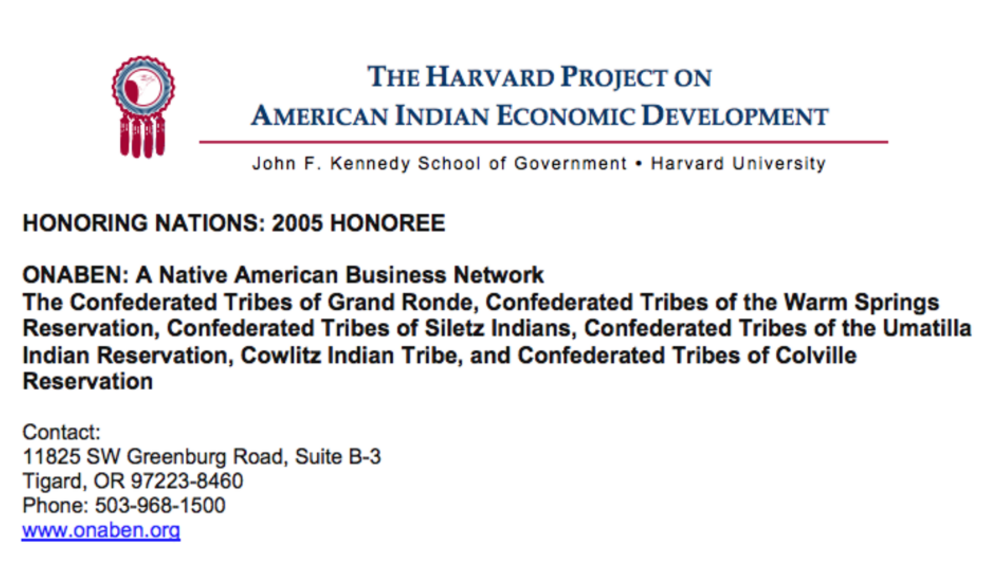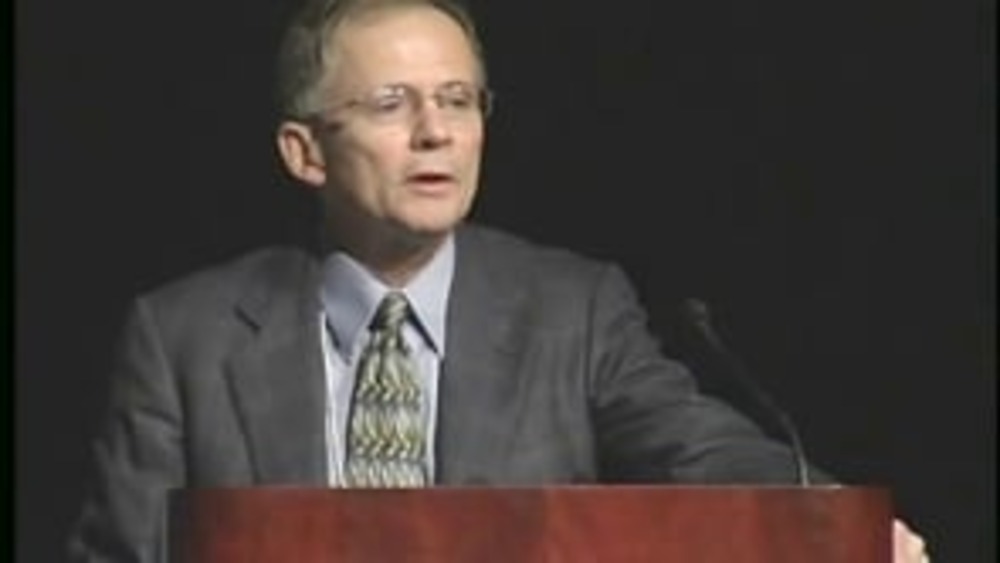ONABEN Executive Director Tom Hampson fields audience questions about ONABEN's work and strategies for cultivating entrepreneurship in Indian Country.
Additional Information
Hampson, Tom. "Native Asset Building (Q&A)." Honoring Nations symposium. Harvard Project on American Indian Economic Development, John F. Kennedy School of Government, Harvard University. Cambridge, Massachusetts. September 17, 2009. Presentation.
Transcript
Susan Jenkins:
"I'm Susan Jenkins with the Cherokee Preservation Foundation. I wanted to ask Tom a question. You have, with your Indianpreneurship been working with a lot of CDFIs. Can you give us an idea of what is emerging as far as new businesses that you're seeing?"
Tom Hampson:
"Indianpreneurship is... She's referring to the curriculum that -- as a social enterprise -- has become a significant part of our mission and our revenue stream. In fact, it is critical to our survival as a social enterprise. We also do training and curriculum sales. Thank you for asking that question. Actually, this comes back to what I was saying about CDFIs, or community development financial institutions, as being sort of introduced notions, by virtue of the fact that they are generous ideas about carrying capital to a place that needs capital with a lot of inherent structure in that program. And what CDFIs promise is debt capital in communities to support entrepreneurship. The reality is that, especially at the start up phase, debt capital is a very inappropriate kind of capital to finance an early stage business -- although entrepreneurs do it all the time, credit cards, friends and family and associates -- but still it's not the most desirable kind of capital. And so we're exploring -- by using the World Bank model, for example -- a way of creating equity capital injections into promising ideas using a business plan style competition that's based on the Alaska Marketplace model, which the Alaska Federation Natives manages in Alaska.
And fundamentally, what that does, where I'm getting to is that the reality is that by injecting capital into anyplace doesn't necessarily generate a particular stream of business or deal flow. That has to come out of the entrepreneurial spirit and the opportunity analysis that they do at the local level, and then that needs to get financed. And so generally,what we're seeing is the tail wagging the dog on the CDFI movement in the northwest. We are collaborating with Shore Bank Enterprise -- cascaded to service CDFI -- to help tribal CDFIs create an entrepreneurship development system and they're doing the back office part of the loan servicing and financing. And there's like eight different CDFIs emerging, there's lots of capital around, but the deal flow is what's lacking. It hasn't generated a lot of new businesses but the businesses that are there -- the mom and pop retail outlets, the gas stations, the hair salons, the woodcarvers and other artists. They're all there in the community and our challenge is to match and marry capital to their needs, and we hope that the CDFI can be a part of that solution."
Mediator:
"We have a question over here."
Mary Lee Johns:
"Hello there. My name is Mary Lee Johns and I'm with Rio Tinto, Senior Advisor on Tribal Governments and Native Communities. My question is to the gentleman. I'm curious about your response to supply chain activities by identifying like... I think that we really missed the boat when it came to the casinos. The fact that those casinos all over Indian Country are being supplied by non-Indian operations and I think that we have to be prepared to begin to develop our supply chains to these... I mean that's where the action is, that's where the cash is and yet we seem to -- as Indian, Native people, Indian people -- we don't look that far down the road. We look to the casino for providing us jobs but we don't look to the actual supplying. We should be the entrepreneurs developing our businesses to supply the casinos or any other business. You're talking about the rodeo. I'm sure you have an Indian contractor who... I know in South Dakota we have all these Indian contractors who have rodeo, they do the rodeo contracts; and so not only do they provide the bucking horses and the bulls and all that... But those are the kinds of things that I think that we as Indian people need to start looking at and I'm just wondering what your response is to that."
Tom Hampson:
"It's an incredibly complex and interesting topic. We have an annual conference, Trading at the River, that; it's a lot like this in terms of its tone and flavor which is thoughtful discussion and talking about how traditions of commerce from the pre-contact can inform new ideas. And that issue is a constant workshop topic every year. We beat it up constantly over and over again. The person that can best address that from a business model standpoint is John McCoy -- sitting next to you -- because there are incredible, the dilemmas that... One of the things that is a very amazing and complex problem is the fact that the business model for a casino, for example, is almost requires a business model for supplying it that is mega in proportion that does not favor an entrepreneurial approach. It might favor a tribal consortium, of which there is at least one now that is trying to be launched that tries to address the enormous capacity problems that Cisco Systems -- or what's the other major food supplier? -- they have solved those problems by being mega corporations. And so the entrepreneur, the efforts for the entrepreneurs to break into those purchasing systems is very complex but it can be done, it just depends on what scale you approach it. It's a whole topic in and of itself."
Mary Lee Johns:
"Well, the reason why I'm asking you that is because there is a model."
Tom Hampson:
"Oh, good. I'd love to hear it."
Mary Lee Johns:
"Well, it's not so much the entrepreneur, but it's based upon a tribal model. These friends from Canada may have heard of Diavik, it's our diamond mine, it's Rio Tinto's diamond mine in Northwest Territory. And what we did was -- we have an agreement with six communities -- and what we did as a company is that we saw an opportunity to help develop a sustaining economic there in Northwest Territory. And so we went in and assisted the communities in developing trucking, which is the ice road truckers, the Tlicho government; we also helped to develop an airline that supplies our, flies our workers in and flies our workers out. So there are some models out there and I'm one that I really believe that this model has to be done in other areas so that when a company wants to come in and do business with a tribe, then we need to be able to participate in the supply chain of that particular business if it's on our reservation. And that's why I say casinos is a perfect model for those kinds of things. Granted, it's becoming more of an older business model, but if we're going to begin to be developing anything else on our reservations, we need to begin to think about the supply chain because that's where the... When you're talking about asset building, that's where asset building can be developed."
Tom Hampson:
"I completely agree but what I'm saying is that... Actually, I would disagree at one level, is that casino may not be the best example. But there are other tribal enterprises over which the tribe has a lot more control over the price points that they have to pay in the marketplace that could be, that we are seeing are much more fertile ground for tribal enterprise and entrepreneurship relationships. The casinos are a little bit different problem but they're still an opportunity."



